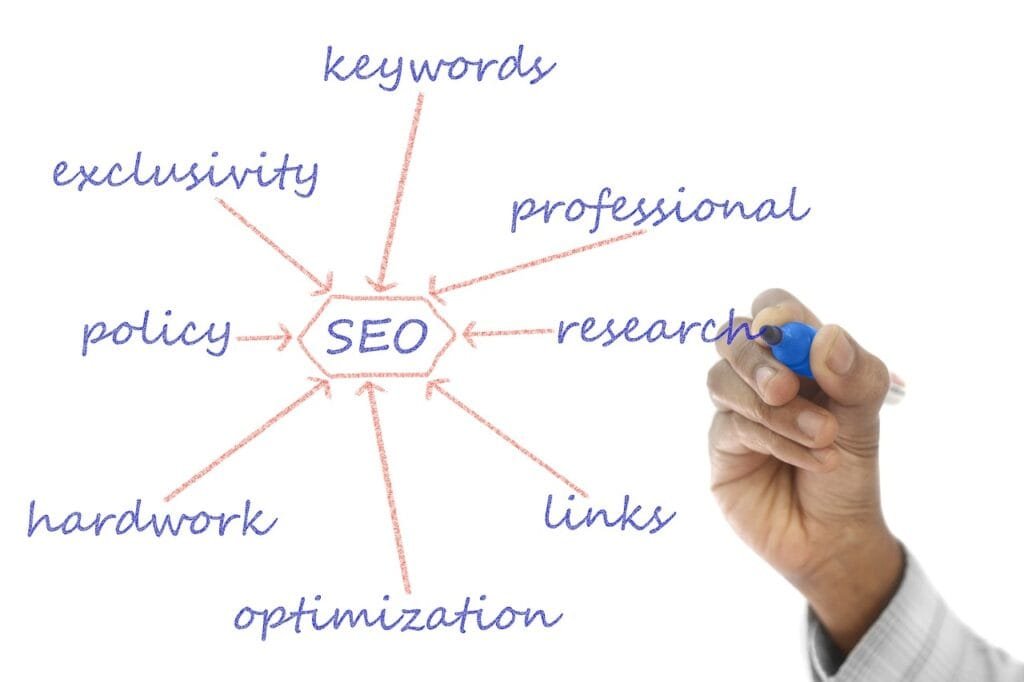This Article has been revised, edited and added to, by Poulomi Chakraborty.
When launching a startup, one of the essential steps to ensuring your business reaches its target audience is by implementing a robust SEO strategy. SEO, or search engine optimization, is like the bloodline for online visibility. At the heart of SEO lies a critical element – keywords. However, not just any keywords, but those that are profitable, relevant, and can catapult your startup’s online presence, driving organic traffic and conversions. If you’ve been wondering how to sift through the vast world of words and phrases to pinpoint those golden nuggets that will skyrocket your startup’s visibility, you’re in the right place.
In this comprehensive guide, we will unravel a meticulously curated step-by-step process to unearth, analyze, and implement profitable keywords tailored to augment your startup’s reach, and subsequently, its success. We will delve deep, exploring tools, techniques, and tips, unearthing the secrets that will place your startup a cut above the rest. Whether you’re an SEO novice or looking to refine your skills, this guide is designed to equip you with the knowledge and tools to elevate your startup’s online footprint.
Grab a cup of coffee, settle in, and let’s embark on this exciting journey of transforming your startup’s online presence, one keyword at a time.
Step 1: Understanding Your Niche

Understanding your niche is the cornerstone of identifying profitable keywords. It’s akin to building a house; a strong foundation ensures stability and longevity. Delving deep into your niche involves a comprehensive exploration of the industry, competitors, and target audience.
Industry Trends and Dynamics
Every industry is fluid, characterized by evolving trends and shifts that could influence consumer behavior and preferences. To fully grasp your niche, subscribe to industry newsletters, and follow influential figures and organizations on social media. Google Trends is a valuable resource for tracking real-time developments and identifying trending topics within your niche.
Understand the regulatory landscape governing your industry. Are there specific legal requirements or restrictions that could affect your startup? Knowledge of these aspects ensures your business aligns with legal standards and capitalizes on available opportunities.
Stay abreast of technological advancements. In today’s digital age, technology is a key driver of change. Understanding technological innovations and disruptions in your industry can uncover novel keywords and topics for content creation.
Competitor Insights
Expand your competitor analysis by evaluating their content strategy. What type of content are they publishing? Assess the quality, frequency, and engagement levels of their content. Tools like BuzzSumo can provide insights into the most shared and engaged content in your niche.
Evaluate your competitors’ social media engagement. Analyze their followers, the type of content shared, and audience engagement. Social listening tools can be instrumental in gauging audience sentiments and identifying popular topics and keywords.
Conduct a SWOT analysis for each major competitor – assessing their Strengths, Weaknesses, Opportunities, and Threats. This holistic view can unveil gaps in their strategy that your startup can exploit.
Audience Persona
Delve deeper into audience analysis by developing detailed audience personas. Personas are fictional, generalized characters representing various user types. They help in understanding the audience’s needs, behaviors, and pain points.
Consider conducting surveys or gathering feedback directly from the current audience or potential customers. Direct insights can unveil specific needs, preferences, and terminologies used by your audience, contributing to a more targeted keyword strategy.
Leverage tools like Hotjar or Crazy Egg for behavioral analysis. These tools provide heatmaps, session recordings, and insights into how users interact with your website, offering clues to their preferences and behaviors.
Integration of Insights
As you deepen your insight into industry trends, competitor strategies, and audience behaviors, the integration of these insights becomes critical. It’s not just about collecting data but making sense of it.
Create a comprehensive report synthesizing all the collected data. Identify patterns, correlations, and insights that can inform your keyword strategy.
Remember, understanding your niche is a continuous learning process. The market, audience preferences, and competitive landscape are always changing. Adopt a learner’s mindset, staying open and adaptable to emerging trends and insights.
Step 2: Initial Keyword Research
With a clear understanding of your niche, it’s time to dive into the exciting world of keyword research. This process is akin to mining; you’re digging deep into the data, uncovering valuable keywords that will illuminate your startup’s online presence.
Diversification of Keyword Sources
Social media isn’t just a platform for engagement but a treasure trove of keyword ideas. Explore trending topics, hashtags, and conversations within your niche. Tools like Brand24 or Keyhole can be instrumental in tracking social media trends and keywords.
Platforms like Quora, Reddit, and niche-specific forums are goldmines for discovering real questions and conversations your target audience is having. It offers insights into the language, terms, and phrases they naturally use.
Advanced Techniques in Keyword Research
Utilize Google’s “People Also Ask” section. It provides related questions that people are searching for, offering additional keyword ideas and insights into user intent.
Leverage Google’s auto-suggest and the related searches feature. Begin typing a keyword, and Google will automatically suggest common searches. At the bottom of the search results, you’ll find additional related search terms.
Conduct a Search Engine Results Page (SERP) analysis for your initial keywords. Analyze the top-ranking pages, their content, and structure. Tools like SurferSEO can offer insights into the keywords for which these pages are ranking.
Keyword Clustering
Group your keywords into clusters. Each cluster should represent a specific topic or theme. This clustering aids in content creation, ensuring that each content piece is rich, diversified, and covers a range of related keywords.
Focus on Semantic SEO, understanding the relationship between words and phrases. Tools like Text Optimizer can help expand your keyword list by suggesting semantically related terms.
Long-Tail Keywords
Long-tail keywords are often overlooked but are pivotal in targeting specific niches. Use tools like AnswerThePublic to discover long-tail keyword variations that are questions. These can be instrumental in creating Q&A style content or FAQ sections.
Leverage AI-powered tools like Clearscope or Frase.io to optimize for long-tail keywords. These platforms provide insights into content optimization, ensuring your content resonates with both search engines and readers.
Integration and Refinement
With a diversified list of potential keywords, the prioritization becomes key. Evaluate each keyword’s potential ROI. Prioritize keywords that are highly relevant, have adequate search volume, and align with your startup’s offerings and audience’s intent.
Remember, initial keyword research isn’t a set-and-forget task. It’s dynamic and requires continuous refinement. Keep an eye on emerging trends, competitor moves, and audience preferences, adapting your keyword list accordingly.
Step 3: Keyword Analysis

With a comprehensive list at hand, the next step is to sieve through, analyzing each keyword’s potential profitability. This is where the wheat is separated from the chaff; not every keyword is worth pursuing.
The analysis phase is where the rubber meets the road. It’s where we apply a meticulous evaluation process to sift through the extensive list of potential keywords, zoning in on those golden phrases that promise to augment your startup’s online visibility and engagement.
Comprehensive Data Metrics
Evaluate the keyword difficulty using tools like Ahrefs or Moz. This metric gives an estimation of how challenging it will be to rank for specific keywords, considering the competition.
Although often associated with paid advertising, CPC can also provide insights into the perceived value of keywords. A higher CPC often indicates that a keyword has a higher conversion potential.
Seasonal Trends and Patterns
Leverage Google Trends to analyze the seasonality of keywords. Certain phrases may have fluctuating popularity throughout the year. Identify these trends to optimize your content calendar.
Review historical data to observe how keywords have performed over time. It offers insights into their sustainability and potential future performance.
Competitor Keyword Intersection
Identify the keywords for which your competitors are ranking. Tools like SEMrush’s Keyword Gap Tool can be instrumental in comparing your domain with competitors, revealing overlapping and unique keywords.
Select keywords where you can outperform competitors. Evaluate their content and backlink profile to identify areas where you can create superior content or garner more authoritative backlinks.
User Intent and Conversion Potential
Analyze keywords with the sales funnel in mind. Identify top-funnel keywords that are informational and bottom-funnel keywords that are transactional to ensure a balanced content strategy that caters to prospects at every stage.
Focus on Conversion Rate Optimization (CRO). Analyze historical data to identify keywords that have led to higher conversions. Tools like Optimizely or Crazy Egg can offer insights into user behavior and conversion paths.
Validation and Documentation
Consider using PPC campaigns to test the performance of selected keywords before investing in long-term SEO strategies. It offers real-time data on their effectiveness in attracting and converting traffic.
Document your findings in a comprehensive keyword analysis report. Include metrics like search volume, difficulty, CPC, and potential ROI. This document becomes a strategic asset, guiding content creation and SEO efforts.
By applying this enriched approach to Step 3, keyword analysis morphs from a theoretical exercise to a pragmatic, data-driven, and strategic process. Each selected keyword is validated, its potential ROI assessed, and its alignment with your startup’s goals and audience’s needs ensured.
Step 4: Intent Analysis

Beyond the numbers, delve into the intent behind each keyword. Every search query has an underlying intent – informational, navigational, transactional, or commercial. Your keywords should not just attract visitors but attract the right kind of visitors, those whose intent aligns with what your startup offers.
Intent Classification
Broaden the scope of intent categories. Besides the common informational, navigational, transactional, and commercial investigation intents, identify subcategories to further tailor your content and SEO strategy.
Recognize the dynamic nature of intent. Users’ intentions can evolve; hence, maintaining flexibility in content and SEO strategies to adapt to shifting intents is crucial.
Behavioral Insights
Leverage advanced features of Google Analytics, like behavior flow and user exploration reports. These provide deeper insights into users’ on-site behavior, indicating their underlying intents.
Implement heatmaps and click tracking tools to visually represent users’ interactions with your site. This data is instrumental in understanding what users are looking for and their patterns of behavior.
Content Intent Alignment
Diversify content types and formats to cater to varied intents. Blogs, how-to guides, videos, infographics, and podcasts can each cater to different user intents.
Analyze the SERP features for targeted keywords. These features often indicate the predominant user intent associated with specific search queries.
Conversion Pathways
Create customized conversion pathways for different intents. Tailor the user journey, from landing pages to call-to-actions, ensuring alignment with users’ specific goals and expectations.
Focus on micro-conversions. Not every user is ready for the final conversion. Identify and optimize for smaller actions that lead users down the conversion funnel.
Evaluation and Refinement
Incorporate user feedback mechanisms on your website. Direct insights from users can provide valuable information on their intents and whether the content meets their expectations.
Implement A/B testing to evaluate different content variations and SEO strategies. Analyze which versions align best with user intent, driving engagement and conversions.
Adopt a continuous approach to intent analysis. As market trends, user preferences, and search algorithms evolve, periodically reassess user intents and adjust your strategies accordingly.
With these added layers, Step 4 is transformed into a detailed, action-oriented plan. It transcends traditional intent analysis, incorporating advanced tools, analytics, and strategies to ensure that every piece of content and every SEO initiative is finely tuned to resonate with the specific, nuanced intents of your target audience.

Related: Check out our free SEO suite

Step 5: Content Mapping
Now that you’ve identified and analyzed potential keywords, the next pivotal step is content mapping. This process involves assigning each chosen keyword to specific content on your website. It’s akin to a chef meticulously preparing a recipe, ensuring each ingredient is perfectly placed to create a culinary masterpiece.
Strategic Content Structuring
Adopt the topic clusters model, where core content pieces (pillar content) are surrounded by a series of related, supportive content (cluster content). This structure boosts SEO and provides users with comprehensive, in-depth information.
Align content with the user’s journey. Each piece should cater to specific stages of the buyer’s journey – awareness, consideration, and decision, ensuring content relevance and engagement.
Multi-Format Content Integration

Integrate multimedia elements like images, videos, and interactive content. These elements enrich user experience and cater to diverse content consumption preferences.
Given the predominance of mobile searches, ensure content is optimized for mobile viewing. Consider factors like responsive design, loading speed, and mobile-friendly layouts.
Personalization and User Engagement
Implement content personalization strategies. Use data analytics to offer tailored content experiences, enhancing relevance and engagement for diverse audience segments.
Incorporate interactive content such as quizzes, polls, and calculators to boost user engagement. Interactive elements can also provide insights into user preferences and behaviors.
Performance and Accessibility
Optimize page load speed. Users’ engagement can be significantly impacted by loading times. Utilize tools like Google PageSpeed Insights to identify and address speed-related issues.
Ensure content accessibility for users with disabilities. Accessibility not only broadens your audience reach but also positively impacts SEO.
Continuous Content Auditing and Optimization
Regularly audit your content to evaluate its performance, relevance, and quality. Identify areas for improvement and opportunities to update, optimize, or repurpose content.
Ensure ongoing alignment of content with SEO trends. As search algorithms evolve, continuously optimize content to meet the changing criteria for high rankings.
Incorporate user feedback to refine content. Utilize comments, reviews, and direct feedback to make informed content enhancements, ensuring it meets and exceeds user expectations.
By amplifying Step 5 with these additional elements, content mapping becomes an intricate, dynamic, and strategic process. It ensures that each piece of content is not just a vessel for keywords but a meticulously crafted asset, designed to engage, inform, and convert while resonating perfectly with SEO algorithms.
Step 6: On-Page SEO Optimization
In the realm of on-page SEO, every detail matters. It’s an intricate blend of art and science, where content, technical elements, and user experience converge to create webpages that are not just searchable but magnetic and engaging.
Content Enrichment
Integrate Latent Semantic Indexing (LSI) keywords to enhance content relevance. LSI keywords are terms and phrases related to the primary keyword, enriching content context and relevance.
Ensure content depth and breadth to cover a topic comprehensively. Google favors content that provides exhaustive, in-depth information on the subject matter.
Technical SEO Excellence
Implement schema markup to enhance SERP listings. It provides additional information to search engines, aiding in more detailed and informative search results.
Optimize for mobile-first indexing. Ensure that the mobile version of the website is fully optimized, as Google primarily uses the mobile version for indexing and ranking.
User Engagement Optimization
Incorporate interactive elements to boost user engagement. Interactive graphics, sliders, and clickable elements enhance user interaction and time spent on the page.
Focus on content readability. Utilize tools like Hemingway Editor to ensure content is easy to read, engaging, and accessible to a broad audience.
Advanced Internal Linking
Implement contextual internal linking, where links are naturally embedded within the content. It enhances user navigation and distributes page authority throughout the site.
Optimize anchor texts to ensure they are descriptive, relevant, and utilize targeted keywords without over-optimization.
Continuous Performance Monitoring and Optimization
Utilize real-time analytics to monitor user behavior, engagement, and conversion metrics. Tools like Google Analytics Real-Time Reports can offer immediate insights.
Regularly perform A/B testing to optimize webpage elements like CTAs, headings, and images. It ensures continuous improvement based on data-driven insights.
Focus on ongoing page speed optimization. Regularly monitor page speed and implement optimizations to ensure fast loading times, enhancing user experience and SEO.
With this enriched perspective on Step 6, on-page SEO optimization becomes a dynamic, ongoing endeavor, meticulously tailored to align with evolving user expectations, search engine algorithms, and your startup’s strategic objectives. Every element, from content and keywords to technical and engagement factors, is finetuned to create webpages that are not just visible but compelling, informative, and conversion-oriented.
Step 7: Monitoring and Analysis

SEO is an evolving landscape. Continuous monitoring and analysis aren’t optional; they’re essential to adapting strategies, capitalizing on opportunities, and mitigating challenges. Here, we detail a dynamic, multi-faceted approach to SEO monitoring and analysis that’s as agile as the digital ecosystem.
Granular Analytics
Delve deeper into analytics that offer insights into user behaviors, journey patterns, and interaction touchpoints. Tools like Hotjar provide visual insights like heatmaps and session recordings.
Create custom dashboards in Google Analytics to have real-time insights on specific metrics tailored to your SEO goals. It aids in instant decision-making.
SERP Performance Tracking
Utilize advanced rank tracking tools like AccuRanker or SEMrush to monitor keyword rankings dynamically, providing insights into visibility and competitive standing.
Monitor the performance and capture rate of featured snippets and other SERP features to understand the visibility and click-through rates.
Competitive Intelligence
Adopt real-time competitor monitoring tools to instantly track competitors’ movements, changes in their SEO strategies, and new content published.
Regularly analyze competitors’ backlink profiles to uncover new linking opportunities and understand their link-building strategies.
Algorithm Update Adaptation
Stay updated with tools that provide real-time alerts on search engine algorithm updates. Quick adaptations to these updates are crucial for sustained SEO performance.
Develop preemptive strategies to adapt to anticipated updates, ensuring minimal impact on your site’s performance and visibility.
Continuous Learning and Skill Enhancement
Invest in ongoing SEO training and workshops for the team. The SEO landscape evolves rapidly, and continuous learning ensures your strategies remain effective.
Join SEO communities and forums to stay abreast of the latest trends, updates, and best practices. Collective intelligence can offer invaluable insights.
SEO Auditing and Reporting
Conduct periodic comprehensive SEO audits to assess the technical health, content quality, and user experience of your website. Identify areas for improvement and optimization.
Develop detailed SEO reports that not only highlight performance metrics but also offer insights, analyses, and actionable recommendations for strategy enhancements.
With these enriched insights, Step 7 transforms into a dynamic, iterative process of constant evolution. It ensures your SEO strategies are not static but are living, breathing entities that adapt, grow, and optimize in real-time, aligning with the ever-evolving digital landscape, search engine algorithms, and user behaviors.
Conclusion
Embarking on the journey of finding profitable keywords for your startup requires a blend of art and science. It’s a meticulous process of understanding your niche, initial keyword research, in-depth analysis, content mapping, on-page SEO optimization, and continuous monitoring and analysis. Every step is pivotal, building upon the last to create a robust SEO strategy that not only enhances your startup’s online visibility but ensures it reaches the right audience, at the right time, with the right content.
Your startup’s success in the digital space is tethered to the effectiveness of your SEO strategy, and at the heart of SEO lies profitable keywords. Armed with this comprehensive guide, you’re not just prepared but empowered to transform your startup’s online presence, one keyword at a time.
Read Next
- SEO Analytic for Startup Local Businesses: Location Insights
- Tracking User Engagement and SEO Analytics for Startups
- How to Optimize Lead Generation Emails for Open Rates
- How to Utilize Customer Referrals for Lead Generation
- The Role of Chatbots in 24/7 Lead Engagement






















Comments are closed.